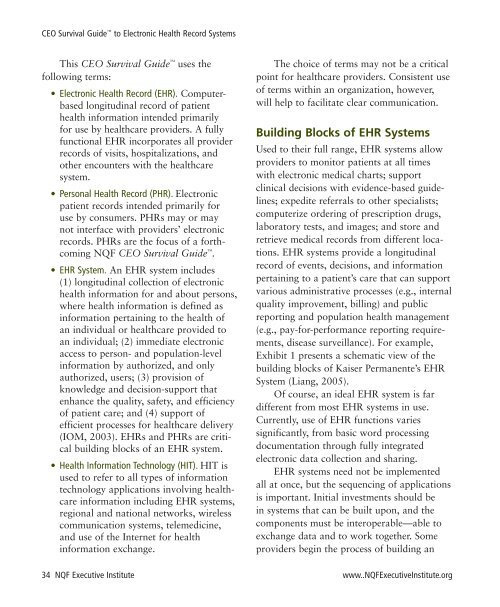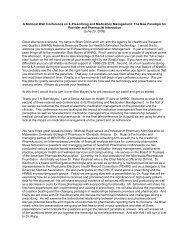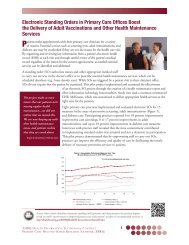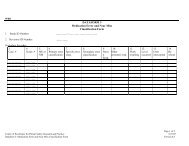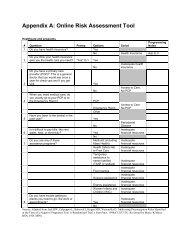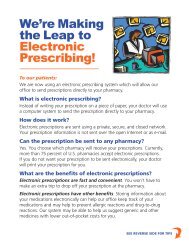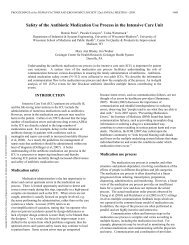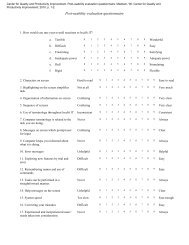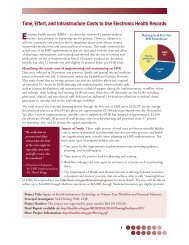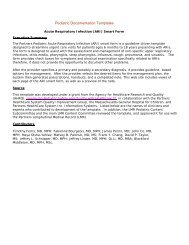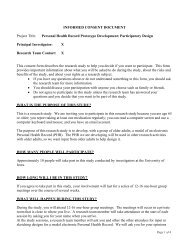CEO Survival Guide - AHRQ National Resource Center; Health ...
CEO Survival Guide - AHRQ National Resource Center; Health ...
CEO Survival Guide - AHRQ National Resource Center; Health ...
You also want an ePaper? Increase the reach of your titles
YUMPU automatically turns print PDFs into web optimized ePapers that Google loves.
<strong>CEO</strong> <strong>Survival</strong> <strong>Guide</strong> to Electronic <strong>Health</strong> Record SystemsThis <strong>CEO</strong> <strong>Survival</strong> <strong>Guide</strong> uses thefollowing terms:• Electronic <strong>Health</strong> Record (EHR). Computerbasedlongitudinal record of patienthealth information intended primarilyfor use by healthcare providers. A fullyfunctional EHR incorporates all providerrecords of visits, hospitalizations, andother encounters with the healthcaresystem.• Personal <strong>Health</strong> Record (PHR). Electronicpatient records intended primarily foruse by consumers. PHRs may or maynot interface with providers’ electronicrecords. PHRs are the focus of a forthcomingNQF <strong>CEO</strong> <strong>Survival</strong> <strong>Guide</strong> .• EHR System. An EHR system includes(1) longitudinal collection of electronichealth information for and about persons,where health information is defined asinformation pertaining to the health ofan individual or healthcare provided toan individual; (2) immediate electronicaccess to person- and population-levelinformation by authorized, and onlyauthorized, users; (3) provision ofknowledge and decision-support thatenhance the quality, safety, and efficiencyof patient care; and (4) support ofefficient processes for healthcare delivery(IOM, 2003). EHRs and PHRs are criticalbuilding blocks of an EHR system.• <strong>Health</strong> Information Technology (HIT). HIT isused to refer to all types of informationtechnology applications involving healthcareinformation including EHR systems,regional and national networks, wirelesscommunication systems, telemedicine,and use of the Internet for healthinformation exchange.The choice of terms may not be a criticalpoint for healthcare providers. Consistent useof terms within an organization, however,will help to facilitate clear communication.Building Blocks of EHR SystemsUsed to their full range, EHR systems allowproviders to monitor patients at all timeswith electronic medical charts; supportclinical decisions with evidence-based guidelines;expedite referrals to other specialists;computerize ordering of prescription drugs,laboratory tests, and images; and store andretrieve medical records from different locations.EHR systems provide a longitudinalrecord of events, decisions, and informationpertaining to a patient’s care that can supportvarious administrative processes (e.g., internalquality improvement, billing) and publicreporting and population health management(e.g., pay-for-performance reporting requirements,disease surveillance). For example,Exhibit 1 presents a schematic view of thebuilding blocks of Kaiser Permanente’s EHRSystem (Liang, 2005).Of course, an ideal EHR system is fardifferent from most EHR systems in use.Currently, use of EHR functions variessignificantly, from basic word processingdocumentation through fully integratedelectronic data collection and sharing.EHR systems need not be implementedall at once, but the sequencing of applicationsis important. Initial investments should bein systems that can be built upon, and thecomponents must be interoperable—able toexchange data and to work together. Someproviders begin the process of building an34 NQF Executive Institute www..NQFExecutiveInstitute.org


